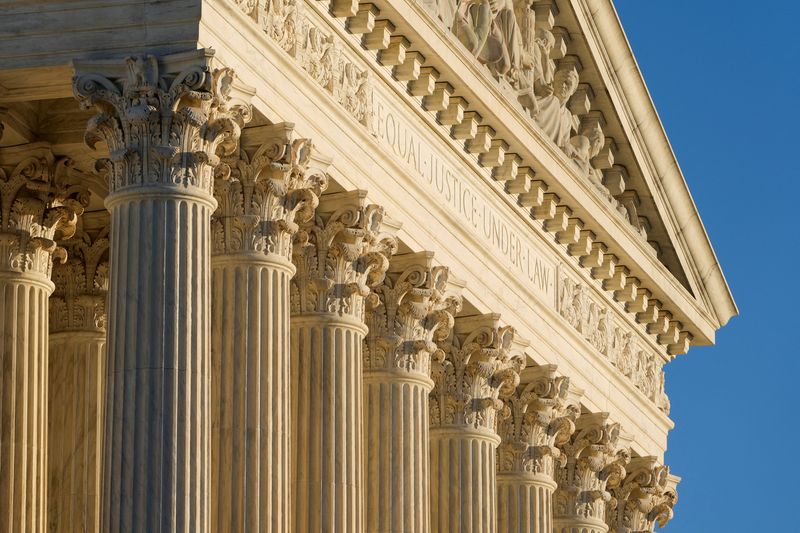After sharp right turn, U.S. Supreme Court conservatives step on the gas
2022.09.28 07:18
[ad_1]

© Reuters. FILE PHOTO: The U.S. Supreme Court stands in Washington, U.S., February 6, 2022. REUTERS/Joshua Roberts/File Photo
By Andrew Chung
(Reuters) – The U.S. Supreme Court last March rebuffed an emergency request by North Carolina Republicans to allow the use in November’s congressional elections of an electoral map they drew that a lower court invalidated for unlawfully disadvantaging Democrats.
It was a short-term setback for the North Carolina Republicans, but they soon will get a chance to claim a bigger legal victory. Conservative Justice Brett Kavanaugh suggested at the time that the justices take up the underlying legal dispute, one that could provide state legislators around the country the ability to enact election policies with less judicial oversight – a Republican goal.
The Supreme Court in June announced it would hear the case in its new term, which begins on Monday. This showed the increasing willingness of its 6-3 conservative majority take on divisive issues as it steers the court on a rightward path.
Following a term when its conservatives delivered blockbuster rulings curtailing abortion access and widening gun rights, the court returns from a summer recess ready to tackle more major cases. Potential rulings in upcoming cases could end affirmative action policies used by colleges and universities to increase campus racial diversity, hobble a federal law called the Voting Rights Act and make it easier for businesses to refuse service to LGBT people based on free-speech rights.
“The justices are taking things that are causing real conflicts around the country, they’re taking issues even if there’s a lot of media attention, even if it’s a hot-button issue – and they’re going to decide it anyway,” said Megan Wold, an attorney and former law clerk to conservative Justice Samuel Alito.
The addition of three justices appointed by Republican former President Donald Trump – Neil Gorsuch in 2017, Brett Kavanaugh in 2018 and Amy Coney Barrett in 2020 – gave the court its current conservative supermajority.
According to Irv Gornstein, executive director of Georgetown University Law Center’s Supreme Court Institute, Kavanaugh now wields outsized influence over the speed and limits of the court’s rightward shift. Gornstein called Kavanaugh the “median justice.”
He does not appear as far to the right as Justices Clarence Thomas, Alito, Gorsuch and Barrett, while Chief Justice John Roberts – an incrementalist conservative – and liberal Justices Elena Kagan, Sonia Sotomayor and Ketanji Brown Jackson are to Kavanaugh’s left.
Gornstein noted during a recent panel discussion in Washington that Kavanaugh has taken to opining on the limits of the majority’s rulings. In the abortion decision, for instance, he issued a separate opinion stating that interstate travel to obtain the procedure is constitutional.
“Make no mistake, for now and for the foreseeable future, this is Justice Kavanaugh’s court,” Gornstein said.
In its most recent term, there were 14 rulings decided on a 6-3 tally with the conservative justices on one side and the liberals on the other. That is up from 10 on strictly ideological lines the previous term, according to legal scholar Adam Feldman, who tracks court data at a website called “Empirical Scotus.”
In the abortion decision, the court ruled 6-3 to uphold the restrictive Mississippi law at issue, though Roberts opposed outright overturning the landmark 1973 Roe v. Wade precedent. Similarly decided on 6-3 votes were the gun rights expansion, cases from Maine and Washington state favoring religious rights and another case that made it harder for the U.S. Environmental Protection Agency to issue rules addressing climate change.
The court appears likely to continue to take up cases particularly important to conservatives, Feldman said.
“They can look for cases that are going to be more ideological because even the weakest link on the right is still pretty far to the right,” Feldman added.
MORE TRANSFORMATION
Further transformation in U.S. law appears likely this term. Two cases could have profound implications for elections in 2024 and beyond.
In the North Carolina case involving the Republican-drawn map of the state’s 14 U.S. House of Representatives districts, Republican lawmakers are advocating for a legal theory gaining popularity among conservatives that could restrict the power of state courts to review actions by state legislatures concerning federal elections. Endorsing the theory would undermine democratic norms, according to critics, even as Republicans at the state level pursue restrictive voting policies and electoral maps skewed in their favor.
Alabama in another case is defending its Republican-drawn map of the state’s seven U.S. House districts that a lower court struck down as discriminatory against Black voters in violation of the 1965 Voting Rights Act.
Also closely watched are cases involving race-conscious student admissions programs used by Harvard University and the University of North Carolina to foster campus racial diversity. A group led by an anti-affirmative action activist challenged those policies as unlawfully discriminatory against Asian American and white applicants.
The court will hear an evangelical Christian web designer’s free speech claim that she cannot be forced under a Colorado anti-discrimination law to produce websites for same-sex marriages. The court did not resolve that issue in a 2018 ruling in favor of a Christian Denver-area baker who refused on religious grounds to make a wedding cake for a gay couple.
Other important cases could make it easier to build on property deemed wetlands without needing a permit under the federal Clean Water Act, or, in a case involving Taser-maker Axon Enterprise (NASDAQ:) Inc, to challenge the authority of federal regulatory agencies without first undergoing an enforcement action.
[ad_2]
Source link








